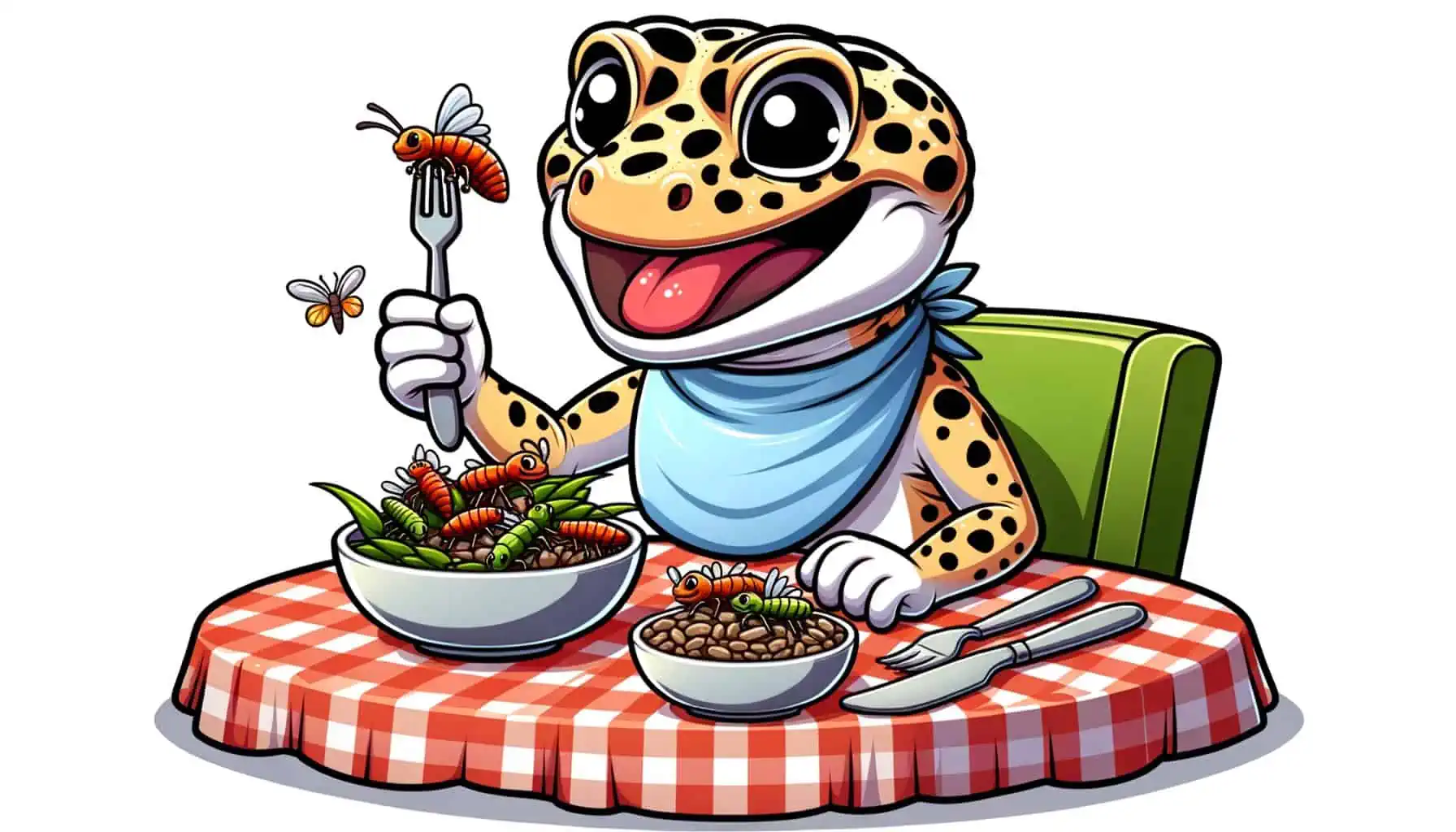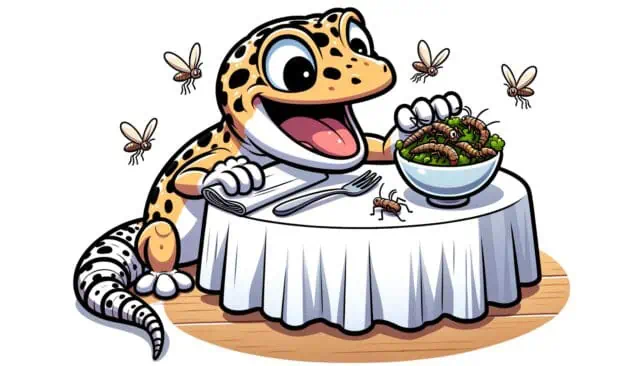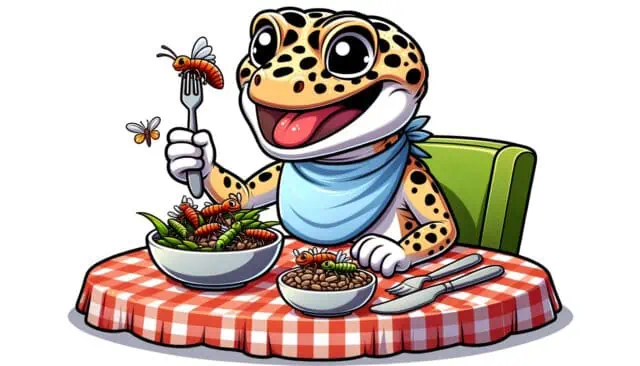Leopard geckos will not overeat to the point of harm. Unlike certain animals, such as fish, leopard geckos have an innate ability to stop eating when they’re full. However, understanding their feeding behavior and requirements is essential for their overall health and well-being.
Natural Eating Habits: Leopard geckos possess an innate ability to cease eating when full, which distinguishes them from animals like fish that may overeat.
Age-Dependent Feeding: While baby geckos need daily feeding with appropriately sized insects, adult geckos require feeding every other day.
Dangers of Overfeeding: Consistent overfeeding can result in obesity, elevating the risk of health issues like fatty liver disease.
Diet for Obese Geckos: For overweight leopard geckos, a well-structured diet plan that focuses on low-fat insects and less frequent feeding is beneficial.
Monitoring is Essential: It’s crucial to keep an eye on the gecko’s weight and overall health, making adjustments to feeding routines as required.
What is Overeating in Leopard Geckos? Can You Overfeed Them?
Overeating in leopard geckos refers to the excessive consumption of food in a short period. However, the term can be a bit misleading. Unlike some species, leopard geckos cannot overeat like fish. They possess an inherent sense to stop eating once they’ve had enough. In essence, while it’s possible to offer them more food than necessary, they will typically stop eating when no longer hungry.
This natural behavior is a protective mechanism. It ensures that they don’t consume more than their body requires. Still, as a responsible pet owner, it’s essential to understand their dietary needs and feeding habits to promote optimal health. Knowing that you can’t truly overfeed them in the same way you might accidentally overfeed fish can provide peace of mind. However, it’s always best to offer the right amount of food to avoid potential health issues down the line.
How Much and How Often Should Leopard Geckos Eat? Age Dependant
The feeding frequency and portion sizes for leopard geckos vary based on their age and size. Understanding these differences is vital for ensuring their proper growth and health.
Baby geckos have a rapid growth rate, demanding more frequent feeding. They should be fed daily. The insects offered to them should be no larger than 3/8 inches. Offering prey that’s too large can be harmful, posing choking risks and digestive issues.
On the other hand, adult geckos have a slower metabolism. Their feeding frequency can be reduced to every other day. At this stage, they can handle full-sized adult insects. This shift in feeding habits from baby to adult stages ensures they receive the necessary nutrients without overconsumption.
Offering appropriately sized prey is paramount. It not only ensures the gecko can consume its food safely but also plays a role in preventing health issues. Overfeeding, or feeding too frequently, can lead to problems like obesity. Obesity in leopard geckos can be a precursor to several health challenges, emphasizing the need to adhere to recommended feeding guidelines.
Causes of Overeating in Leopard Geckos
While leopard geckos have a natural ability to stop eating when they’re full, certain conditions might give the impression they are overeating. It’s essential to understand that they don’t overeat in the same manner as fish. Yet, certain factors might influence their eating habits.
One notable cause is leaving live prey items in the terrarium. When live insects like crickets are left unchecked, a gecko might eat more than its usual portion out of instinct or opportunity. This behavior might seem like overeating, but it’s more about availability.
Another factor is the type of insect being fed. Some insects, like waxworms and butterworms, are fattier. While they can be a treat, frequent feeding of these fatty insects can quickly lead to weight gain in geckos. It’s not necessarily that the gecko is eating in excess, but rather the nutritional content of what they’re eating is leading to rapid weight gain.
Monitoring feeding is crucial. Being attentive to the quantity of food and the feeding schedule can help in regulating the gecko’s diet. By ensuring they receive a balanced diet and not leaving excessive live prey in their habitat, you can mitigate the risks associated with overeating or rapid weight gain.
Long Time Effects of Overeating in Leopard Geckos
Overfeeding leopard geckos over a prolonged period can have detrimental effects on their health. While they naturally stop eating when full, consistent exposure to excessive food, especially fatty prey, can lead to complications.
One of the immediate consequences of overfeeding is weight gain. If not addressed, this can escalate to obesity. An obese leopard gecko is not just visibly larger; it’s at risk for various health issues. The excess fat stored in their body can lead to conditions like fatty liver disease, where the liver accumulates too much fat and can’t function properly.
Such health conditions are not just internal. The physical burden of carrying excess weight can strain a gecko’s skeletal structure and reduce its mobility. Over time, the combined negative health effects of obesity and related diseases can shorten a leopard gecko’s lifespan.
Should Obese Leopard Geckos Be Put On a Diet?
Obese leopard geckos certainly benefit from a structured diet. Obesity in these reptiles is not merely an aesthetic concern; it poses several health risks and complications that can adversely affect their quality of life.
Obesity in leopard geckos can lead to problems such as joint issues, reduced mobility, and even internal complications like fatty liver disease. These conditions can be painful and significantly decrease the gecko’s lifespan. Thus, addressing obesity through a proper diet plan is crucial to mitigating these risks and ensuring the gecko’s health and longevity.
When considering a diet plan for an obese leopard gecko, several key steps and considerations come into play:
- Food Type: Offer low-fat insects like crickets and avoid fatty insects such as waxworms and butterworms. Every once in a while, fatty insects can be given as treats, but they shouldn’t be the primary food source.
- Feeding Frequency: Instead of daily feeding, consider feeding adult geckos every two or three days. This reduced frequency allows them to burn off the stored fat.
- Portion Sizes: Offer fewer insects per feeding session. For instance, if you used to offer ten crickets, reduce this to six or seven. Over time, as the gecko loses weight, you can adjust the portion size accordingly.
- Monitor and Adjust: Regularly weigh the gecko and monitor its health. Adjust the diet plan based on the gecko’s weight loss progress and overall health.
Watch out, though. You don’t want to get them to the other extreme, where the gecko is underweight.







